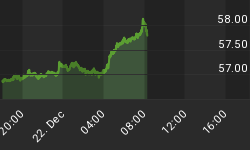This week, Japan's Government Pension Investment Fund (GPIF), the world's largest public pension fund, announced that it may be forced to sell a portion of it Japanese government bond (JGB) holdings to satisfy cash requirements. This is a remarkable event because the GPIF had been the biggest buyer of JGBs.
A Bloomberg article discussing this announcement is available online at: http://www.bloomberg.com/apps/news?pid=20601101&sid=aHqU_yTjmPzQ
As background, Japan's on-balance sheet debt to GDP is tremendous and makes the US fiscal situation look strong by comparison (US off-balance sheet liabilities such as Medicare and Social Security are greater problems). Japan's accumulation of debt has been possible because of buyers such as the GPIF.

Despite high levels of debt, the Japanese government has been able to continue borrowing even at rock-bottom interest rates because those funding the deficits were primarily the Japanese. Large buyers of government debt such as the GPIF and individual people did not demand higher interest rates and thus without push back from foreign lenders debt continued to grow unabated. Furthermore, even with Japan continuously printing new Yen through quantitative easing, interest rates did not rise as the government monetized debt. This week's announcement, however, adds a new twist to Japan's zero interest rate policy and quantitative easing measures.
If Japan's pension fund begins to sell a portion of its JGBs there would be many negative implications. As the market anticipates that a major buyer of JGBs has left the market and will begin to sell bonds, bond prices will fall and interest rates will rise. The only course of action is for all holders of JGBs to reduce their holdings, potentially creating a downward spiral. As interest rates rise, this creates another headwind for the Japanese economy, undermining the efforts of the Japanese central bank and government. More than likely, as interest rates rise, the Japanese central bank will increase its quantitative easing measures (print even more money) to intervene in the government bond market. The result for Japan, and for all countries embarking on money printing, can only be a loss of confidence in paper currencies resulting in higher consumer prices.
As stated above, the Japanese Central Bank, like the Federal Reserve, is doing everything it can to keep interest rates low. In light of the recent weakening of JGBs following the announcement by the GPIF, it is worth considering another way for the GPIF to raise funds to meet its cash needs. A compelling argument can be made for the GPIF to sell some of its 7.8% position in overseas bonds before selling any of its JGBs. This argument is reasonable for two reasons. First, even though the fund is overweight Japanese bonds, the country as a whole is overweight US government bonds and the Japanese government still dictates the weightings of the portfolio's holdings. Second, and more importantly, if the GPIF sells foreign bonds first, it will delay the harmful effects of rising interest rates for the Japanese economy. The short-term benefits to the Japanese economy from the delay in rising long-term interest rates will be detrimental to the US economy as US long-term interest rates would rise instead. The potential for the GPIF to sell US government bonds, which it will have to do one day regardless, means that it has joined an ever-increasing list of possible sellers of US government bonds.
The world was awash in debt prior to the housing and financial crisis. To combat the crisis, governments and central banks around the world are following the same course of action that created these problems, which is issuing debt to stimulate growth. This policy can only work if there is enough savings held by private citizens to fund government deficits and if interest rates are at attractive levels. However, the world's appetite for US government debt has reached its capacity as demonstrated by the recent meeting of our largest creditors, Brazil, Russia, India and China. Also, it now appears that even the Japanese own as much Japanese government debt as they can handle. Without central bank intervention, the result of too much government debt would be rising government interest rates combined with forced government spending cuts. However, Japan's long-running policy of quantitative easing, and the Federal Reserve's recent move in that direction, means that money printing and the monetization of debt will go into overdrive. This scenario creates much doubt about the current paper-money monetary system and forces every person to reconsider the safety of their savings.















